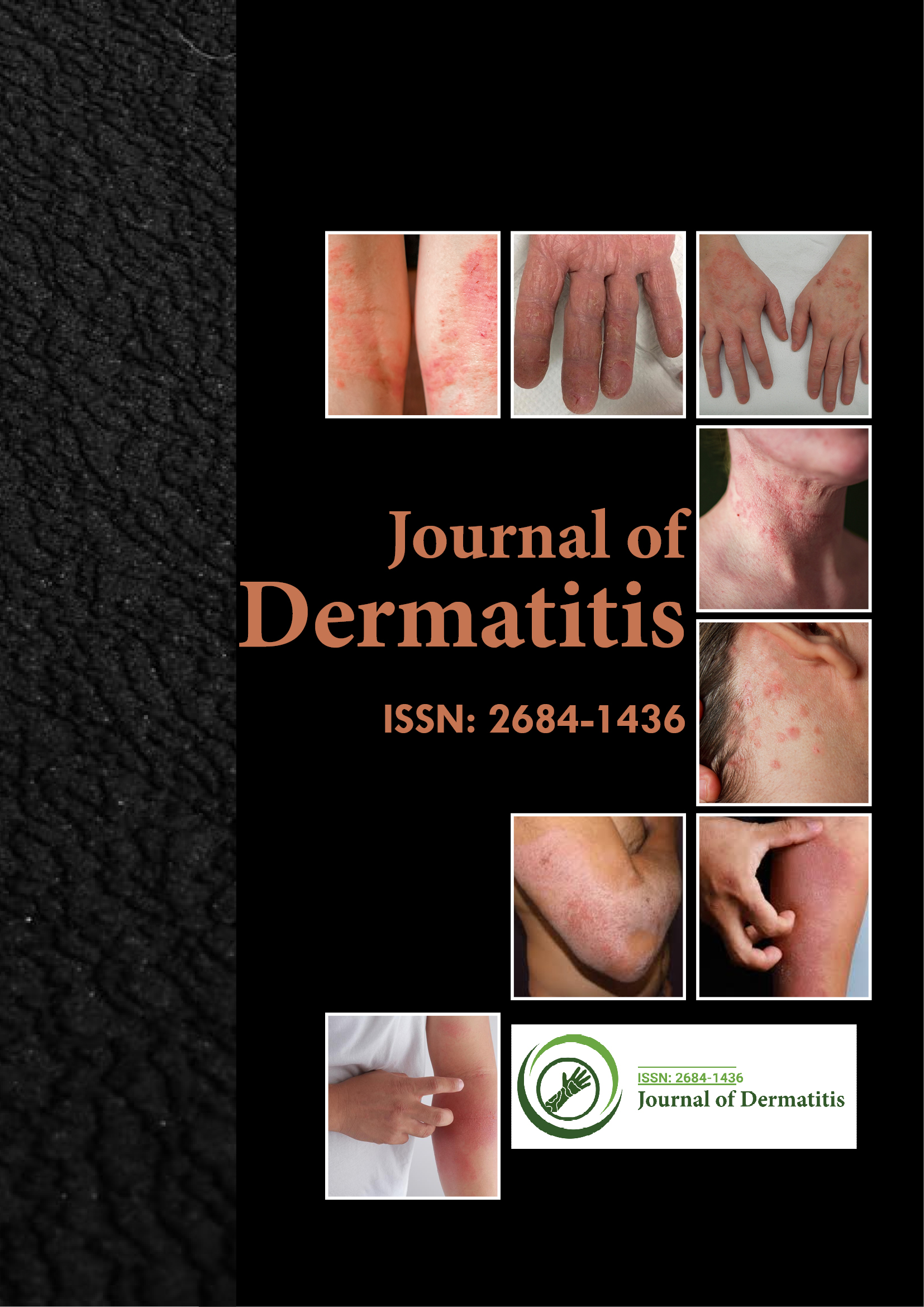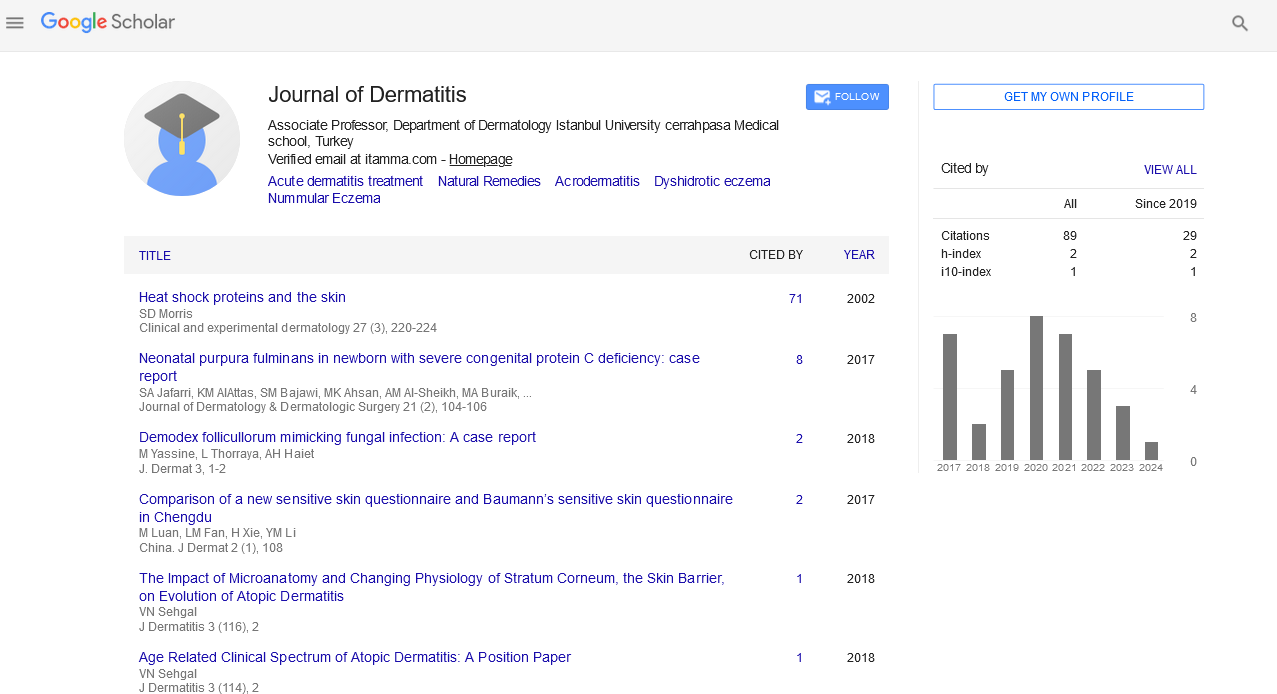Indexed In
- RefSeek
- Hamdard University
- EBSCO A-Z
- Euro Pub
- Google Scholar
Useful Links
Share This Page
Journal Flyer

Open Access Journals
- Agri and Aquaculture
- Biochemistry
- Bioinformatics & Systems Biology
- Business & Management
- Chemistry
- Clinical Sciences
- Engineering
- Food & Nutrition
- General Science
- Genetics & Molecular Biology
- Immunology & Microbiology
- Medical Sciences
- Neuroscience & Psychology
- Nursing & Health Care
- Pharmaceutical Sciences
Commentary - (2022) Volume 7, Issue 6
Dermatologic Signs of Hypereosinophilic Syndrome
Mellan Strak*Received: 01-Nov-2022, Manuscript No. JOD-22-19069; Editor assigned: 04-Nov-2022, Pre QC No. JOD-22-19069 (PQ); Reviewed: 18-Nov-2022, QC No. JOD-22-19069; Revised: 25-Nov-2022, Manuscript No. JOD-22-19069 (R); Published: 02-Dec-2022, DOI: 10.35248/2684-1436.22.7.168
Description
The Hypereosinophilic Syndrome (HES) includes a variety of clinical symptoms that share the following three characteristics. (1) a peripheral eosinophil count greater than 1.5 × 109/L for more than 6 months; (2) evidence of organ involvement, excluding benign eosinophilia; and (3) the absence of other eosinophilia-causing conditions, such as malignancy, collagen vascular disease, parasite infestation, and allergy.
The F/P+ variant of the hypereosinophilic syndrome is primarily caused by an interstitial chromosomal deletion on band 4q12, which results in the creation of the FIP1L1- PDGFRA fusion gene. The lymphocytic variant, which is more frequently characterised by a CD3-CD4+ phenotype, is caused by increased interleukin (IL)-5 production by a clonally expanded T-cell population.
Granulocyte-macrophage colony-stimulating factor (GM-CSF), IL-5, and other cytokines all promote the development of eosinophils. Eosinophilia has been linked to enhanced lymphoma production of these cytokines in 3 patients with Tcell lymphomas. The stimulatory activity of IL-5 appears to be restricted to eosinophils, which suggests it to be the dominant factor in eosinophil proliferation, in contrast to the actions of IL-3 and GM-CSF on other bone marrow-derived lineages. Although the exact cause of hypereosinophilic syndrome has not yet been identified, evidence suggests that CD4+ Tlymphocyte clones produce more IL-5 than normal.
However, eosinophils have been revealed to contain IL-5 mRNA and protein; as a result, the rise in this cytokine cannot be attributed to T cells alone. In addition, since some patients with hypereosinophilic syndrome also have concurrent neutrophilia, it is possible that other factors besides IL-5 are at play. Eosinophils have been proven to produce GM-CSF and IL-3, and the synthesis of GM-CSF in T-cell clones from individuals with hypereosinophilic syndrome has also been shown.
In the hypereosinophilic syndrome, eosinophils invade numerous organs where they release granule proteins like eosinophil peroxidase, major basic protein, eosinophil-derived neurotoxic, and eosinophil cationic protein that cause tissue damage. Additionally, they discharge proinflammatory cytokines, including as interleukin 1 alpha, tumour necrosis factor-alpha, interleukin 6, interleukin 8, IL-3, IL-5, GM-CSF, and macrophage inflammatory protein, which draw additional eosinophils and inflammatory cells to the area. The most frequent cause of death in hypereosinophilic syndrome is cardiac involvement. Eosinophil infiltration in the heart causes endomyocardial fibrosis, which then leads to Congestive Heart Failure (CHF) and eventual mortality. Patients with peripheral eosinophilia owing to other reasons do not develop pathology similar to hypereosinophilic syndrome, therefore this infiltration is necessary for tissue damage to happen.
Adult patients with hypereosinophilic syndrome have been reported to have the FIP1L1-PDGFRA mutation (Platelet- Derived Growth Factor Receptor Alpha Chain). In particular, a new oncogenic mutation (FIP1L1-PDGFRA), which causes clonal lines of pathologic cells and a constitutively active Platelet- Derived Growth Factor Receptor-Alpha (PDGFRA), has consistently been linked to a primary eosinophilic disease.
The prevalence and related clinicopathologic characteristics of the mutation in FIP1L1-PDGFRA were investigated by Pardanani et al. in 89 persons who presented with an absolute eosinophil count more than 1.5 × 109/L. FIP1L1-PDGFRA was found in bone marrow cells using a method based on fluorescence in situ hybridization, according to Pardanani and his team. Only 14% of the remaining 81 patients with primary eosinophilia had FIP1L1-PDGFRA deficiencies, compared to none of the 8 patients with reactive eosinophilia (11 patients). The mutant FIP1L1-PDGFRA was not present in any of the 57 individuals with hypereosinophilic syndrome and was present in 10 (56%) of the 19 patients with Systemic Mast Cell Disease Associated with eosinophilia (SMCD-eos). Therefore, it would appear that FIP1L1-PDGFRA is not the exclusive cause of hypereosinophilic syndrome. However, following imatinib therapy, 10 instances of hypereosinophilic syndrome showed a 40% partial response rate.
Citation: Strak M (2022) Dermatologic Signs of Hypereosinophilic Syndrome. J Dermatitis. 7:168.
Copyright: © 2022 Strak M. This is an open-access article distributed under the terms of the creative commons attribution license which permits unrestricted use, distribution and reproduction in any medium, provided the original author and source are credited.

